AI Generated Content Explained: Tools, Technologies, and Ethical Impact of Automated Media in 2025
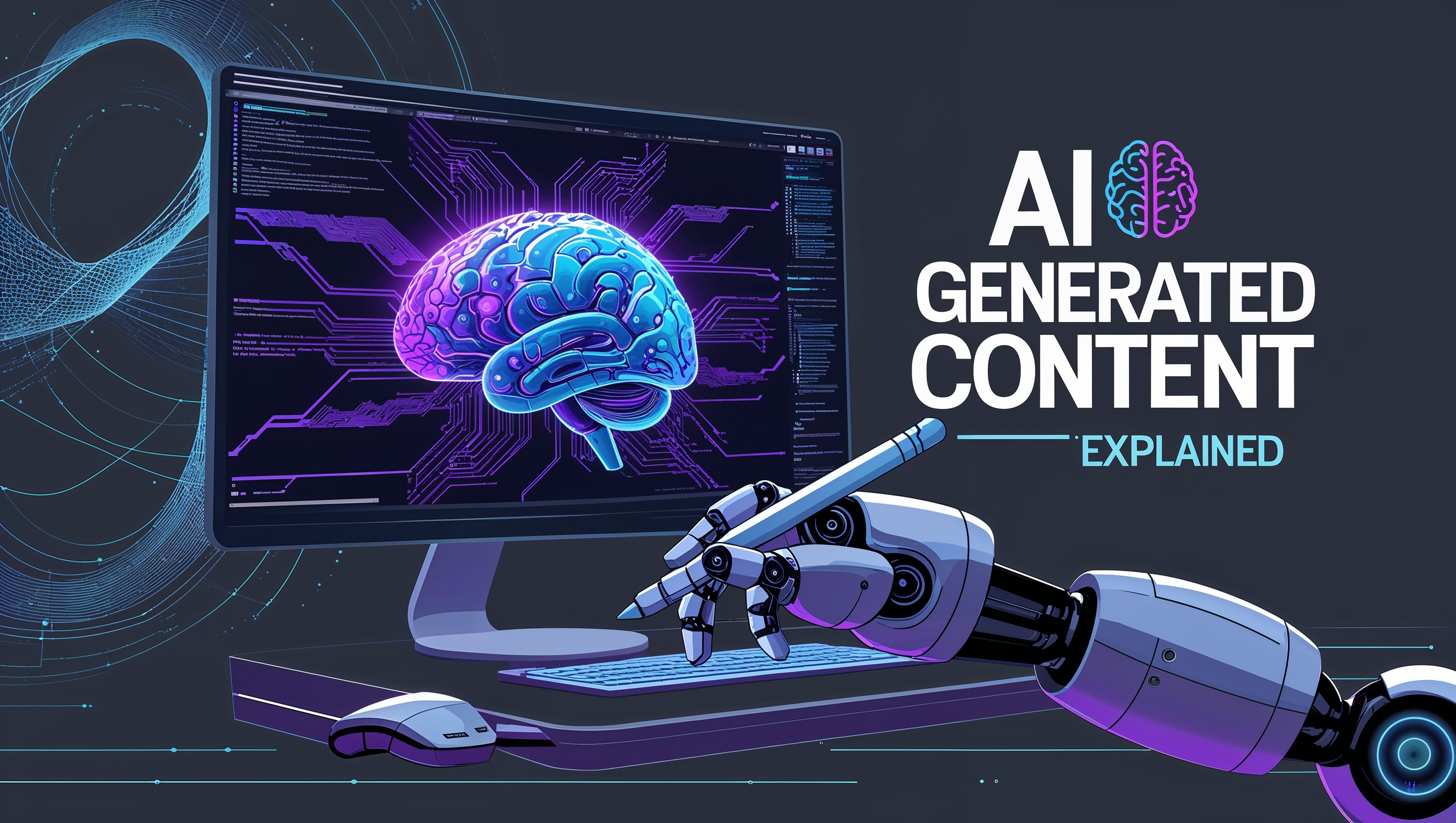
In 2025, AI generated content is no longer a futuristic concept—it’s a mainstream solution reshaping how we write, design, and communicate.
From blogs and emails to videos and graphics, artificial intelligence content creation is powering everything from marketing campaigns to journalistic reporting.
As someone deeply embedded in the world of generative tools, I’ve watched machine-generated text and AI-generated media evolve from basic templates to sophisticated storytelling systems.
Thanks to breakthroughs in natural language generation (NLG) and deep learning content generation, AI can now mimic human tone, structure, and logic with surprising accuracy.
Whether you're using GPT content generation for long-form articles or experimenting with AI image creation for brand visuals, the shift is undeniable—and it’s just getting started.
This article breaks down how it works, where it’s useful, what tools lead the market, and how to use AI responsibly without sacrificing originality.
Let’s explore the power and potential of AI generated content in today’s digital landscape.
1. What Is AI Generated Content?
AI generated content refers to text, images, videos, or other media created using artificial intelligence models, rather than being written or designed by humans. At its core, it’s content that’s produced or heavily assisted by machine algorithms—usually based on deep learning and large-scale language or image datasets.
What once took hours to write, design, or edit can now be generated in minutes using AI writing tools, natural language generation (NLG), and synthetic content systems. These systems interpret human prompts and generate contextually relevant outputs. Depending on the platform, this might mean blog posts, ad copy, illustrations, or even explainer videos—all machine-generated but increasingly human-like in tone and structure.
As someone who has worked closely with tools like GPT-4, Midjourney, and Runway, I’ve seen firsthand how fast this space is evolving. What started as quirky, rough drafts are now full-fledged content solutions integrated into agency workflows and editorial calendars.
The most common forms of AI-generated content include:
- Machine-generated text: Blog articles, product descriptions, email sequences
- AI image creation: Illustrations, thumbnails, ad creatives
- AI video generation: Explainer videos, animated presentations, avatars
- Synthetic content: Virtual influencers, voiceovers, and deepfake media
While each type differs in output and technical process, they all share a common foundation—automation powered by generative AI technology.
This type of content is transforming industries like marketing, journalism, e-commerce, and entertainment. It’s helping brands scale faster while freeing up creative teams to focus on high-level strategy, review, and refinement.
The important thing to remember is that AI-generated media doesn’t replace creativity—it enhances it. When used wisely, it acts like a digital assistant with limitless potential.
2. How Does AI Content Creation Work?
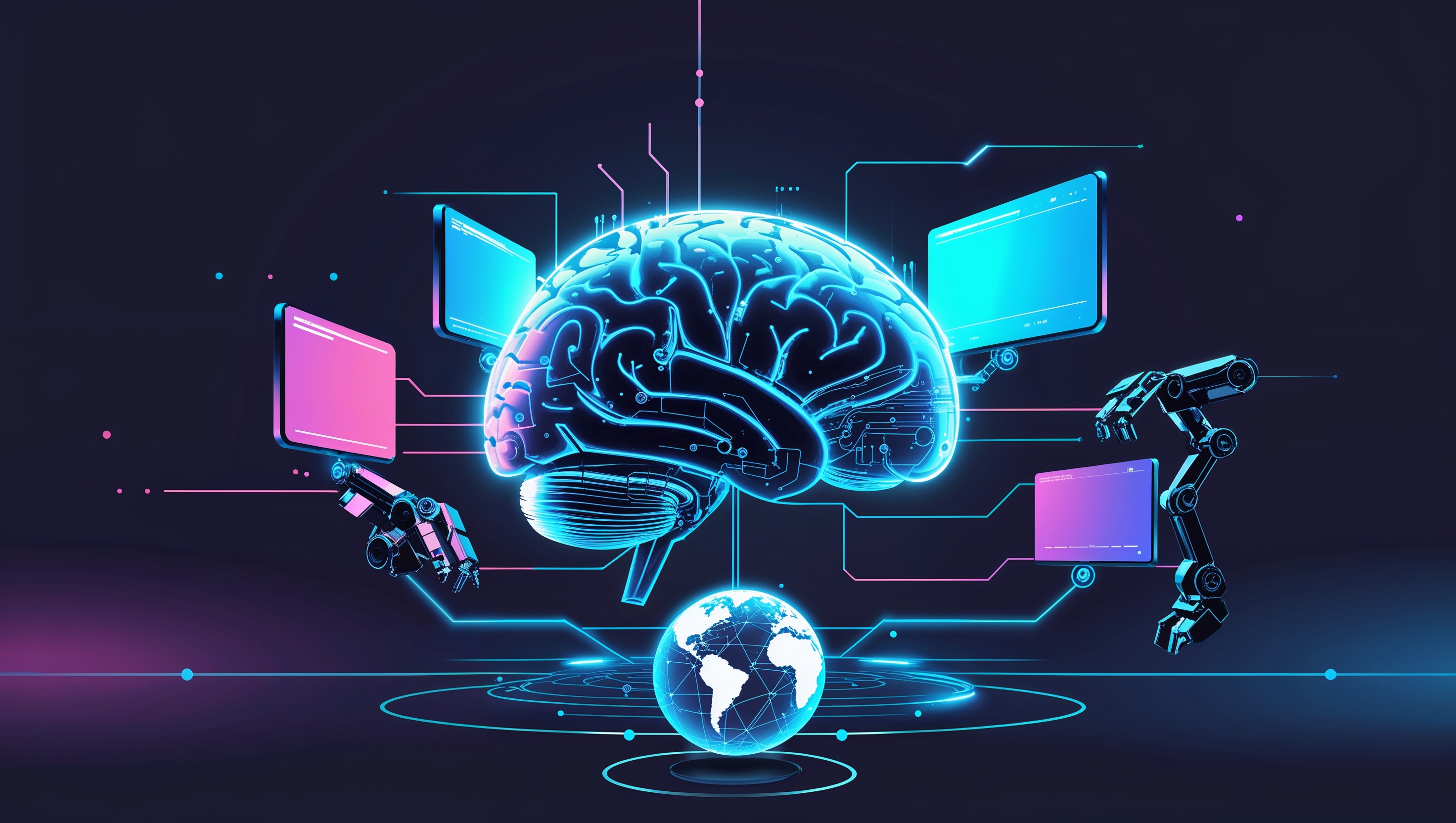
AI generated content works through large-scale machine learning models trained on vast datasets.
Text generation relies on natural language generation (NLG).
Image and video creation depend on generative adversarial networks (GANs) or diffusion models.
GPT models, like GPT-4, predict text based on context and prompt structure.
Stable Diffusion and Midjourney generate images using text-to-visual translation.
Voice and video use multimodal AI systems for audio-visual synthesis.
The content creation starts with a prompt—human instructions to guide the AI.
Prompts can be detailed or simple, depending on the platform’s sophistication.
AI tools then break down these prompts using tokenization and attention mechanisms.
The model references its training data and assigns probabilities to words or images.
The most relevant combinations are selected and outputted in sequence.
For text, the result may be paragraphs, summaries, or marketing copy.
For images, it could be artwork, mockups, or photo-realistic visuals.
AI video generation follows similar logic, with frames built from learned motion patterns.
Deep learning enables these tools to improve the more they’re used.
Platforms like Jasper, Copy.ai, or Sudowrite use NLG to craft human-like content.
Tools like DALL·E and Runway use image-based learning to create visuals.
AI tools are trained to mimic tone, syntax, and visual style.
Many tools offer fine-tuning or memory features to retain brand voice.
Most commercial systems run on cloud infrastructure for scalability.
The generated output can often be edited or regenerated instantly.
This loop—prompt, generate, refine—is the basis of AI-driven storytelling.
Users can guide the AI to revise tone, structure, or format as needed.
Some advanced platforms also allow API integrations for automated workflows.
In short, AI content automation mimics the creative process at scale.
But even the smartest models still rely on human review to ensure accuracy.
The power lies in how well the human and AI collaborate.
3. Common Types of AI Generated Content
The beauty of AI generated content lies in its versatility. As the technology evolves, so does the range of formats it supports—each tailored to specific use cases and industries.
The most widely used type is machine-generated text, which includes everything from blogs and email newsletters to ad headlines and product descriptions. Platforms like Jasper and Writesonic allow marketers to create high-converting copy without starting from scratch.
Another fast-growing category is AI image creation. Tools like Midjourney, DALL·E, and Canva’s Magic Studio generate visuals for social media, ads, websites, and more. These platforms allow creators to build custom graphics based on just a line or two of description.
Video is catching up, too. With AI video generation, businesses can produce explainers, tutorials, or promotional videos using avatars, stock footage, or even text-to-video engines. Tools like Pictory and Synthesia are helping marketers scale multimedia content faster than ever.
Synthetic content—such as deepfakes, voice cloning, or virtual influencers—is also gaining traction, though it comes with its own ethical considerations. These technologies are often used in entertainment, gaming, and immersive experiences.
AI is even being used for audio generation, from podcasts to background music, creating unique soundtracks without needing a human composer.
These types aren’t mutually exclusive. Many teams use a combination—text for articles, images for promotion, video for engagement—within the same campaign. The flexibility of AI writing tools and generative systems gives creators more room to experiment, iterate, and scale content across channels with consistency and speed.
4. AI Writing Tools & Content Automation Software
As the demand for automated content writing grows, a robust ecosystem of AI writing tools has emerged to help businesses scale their content strategies.
These platforms combine natural language generation (NLG) and deep learning with user-friendly interfaces, offering everything from blog creation to product descriptions.
Here’s a comparison of some of the most prominent tools in 2025:
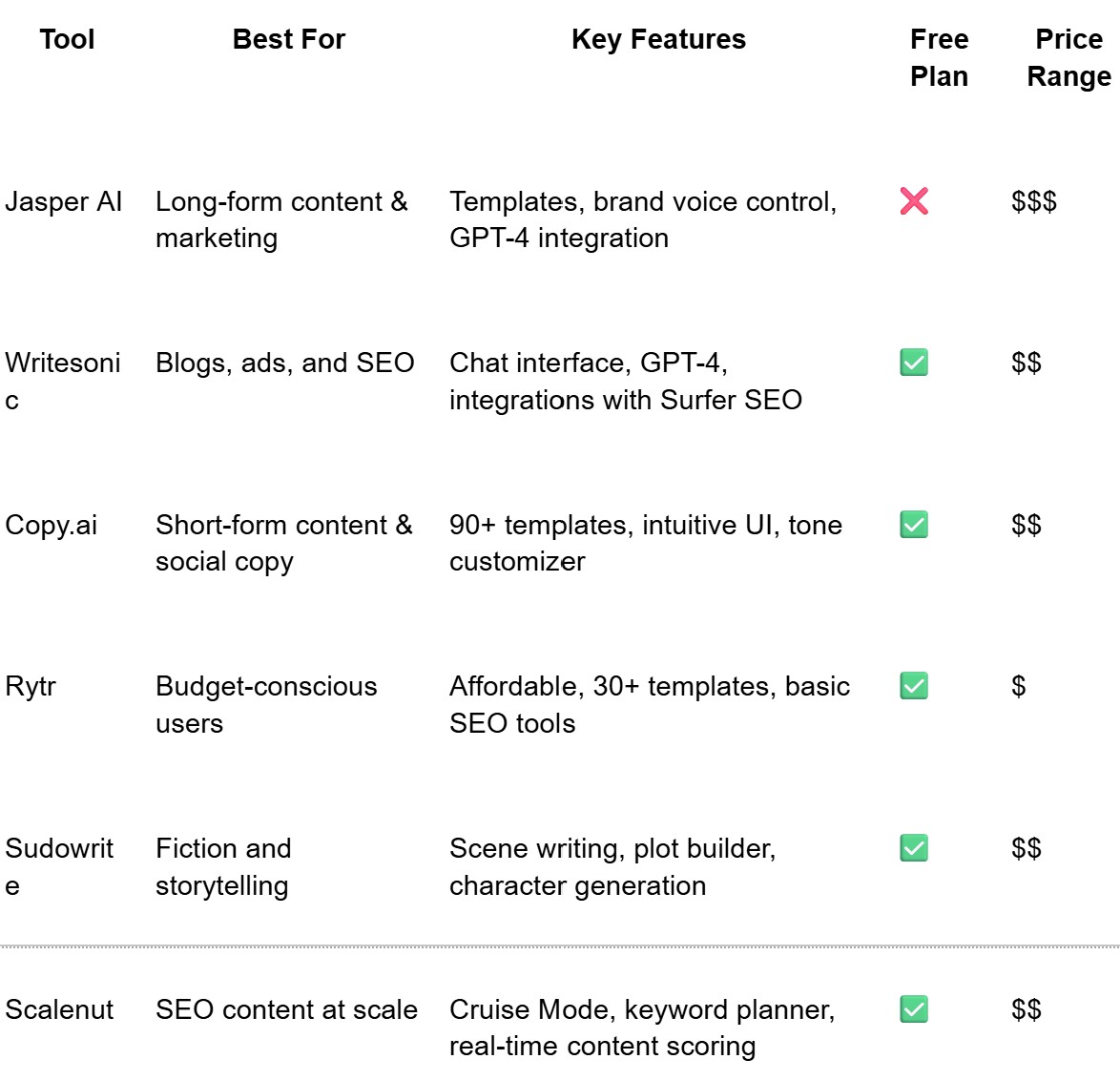
These tools offer powerful options across niches:
- Blog and article generation
- Social media caption writing
- Email copywriting
- Website landing pages
- AI-driven storytelling for creative writing
Most platforms allow integration with tools like WordPress, Shopify, or SEO platforms, creating end-to-end content automation workflows.
From my own usage across client campaigns, AI writing tools reduce production time by 60–80%, especially for high-volume needs.
And while automation accelerates delivery, the real advantage lies in how these tools scale ideation and consistency—freeing up time for strategy, editing, and audience targeting.
5. Benefits of Using AI for Content Creation
The rise of AI generated content has introduced a wave of efficiency, personalization, and scale that was unimaginable just a few years ago.
AI tools now empower creators to produce content at lightning speed, without compromising consistency or tone. Whether it’s machine-generated text or AI video generation, these platforms enable content delivery at a volume that suits modern demands.
For marketers, one of the biggest advantages is time savings. Writing blog posts, email campaigns, and ad copy that used to take hours can now be drafted in minutes with tools like Jasper or Copy.ai.
Scalability is another key strength. AI systems can generate hundreds of variations of the same message, making them ideal for A/B testing, multilingual outreach, or hyper-personalized targeting.
AI tools are also a huge asset for small businesses and solopreneurs who lack large teams or budgets. With affordable subscriptions, even entry-level users can create professional-quality content.
Some of the major benefits include:
- Speed: Rapid content generation across formats (text, image, video)
- Cost-effectiveness: Reduces need for multiple team members or external writers
- Personalization: Tailors messages for different audiences, personas, or campaigns
- 24/7 Availability: AI never sleeps, enabling round-the-clock creation
- Consistency: Maintains voice, structure, and tone across all content types
- Language Diversity: Supports multi-language content creation and translation
From my professional experience, the biggest game-changer is how AI writing tools reduce creative fatigue. They provide structure, eliminate blank-page syndrome, and help you maintain output even during mental lulls.
When integrated with workflows like SEO optimization and campaign planning, content automation software becomes a force multiplier—not just a convenience.
6. Limitations and Risks of AI Generated Content
Despite the innovation behind AI generated content, it’s not without serious limitations.
AI still struggles with factual accuracy, often producing “hallucinated” content that seems plausible but isn’t true.
There’s a lack of true creative intuition, which can result in repetitive or generic phrasing.
Many tools require strong prompting skills to produce high-quality output.
Ethical concerns arise with synthetic content such as deepfakes or fake testimonials.
AI-generated media may include biased language if not carefully trained or edited.
There’s an over-reliance risk—users may avoid deeper thinking and rely too heavily on tools.
AI cannot currently replace emotional intelligence, human insight, or cultural nuance.
Plagiarism or content similarity can occur if AI pulls from similar patterns.
Search engines like Google may penalize low-quality or AI-spammed content.
Here’s a breakdown of key risks:
- Hallucination: Confidently incorrect or misleading information
- Bias: Trained on skewed datasets, leading to insensitive content
- Over-automation: Weakens brand originality and user connection
- Compliance risks: AI may generate non-compliant or unverified claims
Even in marketing, I’ve found that outputs often require 15–30% editing to align with tone, accuracy, or brand guidelines.
AI can support human creativity, but it shouldn’t replace oversight, originality, or ethical responsibility.
7. Legal and Ethical Implications
As AI-generated media becomes more mainstream, the legal and ethical lines surrounding content creation are becoming increasingly complex.
The biggest question often raised is: Who owns AI-generated content? If a machine wrote it, does the user hold the rights—or the platform that trained the model?
Currently, most platforms pass usage rights to the creator, but this may change as copyright laws evolve. Legal scholars and regulators are watching this space closely, especially in the U.S., EU, and Asia.
Another issue lies in transparency. Should readers be informed that a piece of content was written or influenced by AI? In journalism and academia, the answer is increasingly “yes.” But in marketing, disclosure remains inconsistent.
The use of synthetic content like deepfakes or voice clones introduces even deeper concerns. While these tools are powerful for storytelling, they can also be misused to spread disinformation or infringe on someone's likeness.
From an ethical standpoint, there’s also growing concern about AI bias. If a model is trained on unbalanced or culturally skewed data, the content it generates may inadvertently reflect those biases.
Marketers and content creators must take proactive steps:
- Always review and fact-check AI-generated outputs
- Disclose AI usage when appropriate
- Avoid automating sensitive or legal topics
- Respect copyright, likeness, and consent boundaries
From my experience working with content teams, the best approach is hybrid: let AI do the heavy lifting, but always insert human judgment, empathy, and ethics into the final piece.
The future of AI writing tools will depend not just on performance—but also on responsibility.
8. Future of AI in Content Creation
The future of AI generated content is both promising and transformational.
With advancements in generative AI technology, we’re seeing smarter, faster, and more contextual systems emerge every quarter.
Tools are shifting from just generating words to creating immersive experiences—from static blog posts to dynamic, multimedia storytelling.
One of the most exciting frontiers is AI video generation. Platforms like Synthesia are now able to produce entire video tutorials or explainer content using avatars, voiceovers, and script automation—all without a camera crew.
Here’s how the future is shaping up across formats:
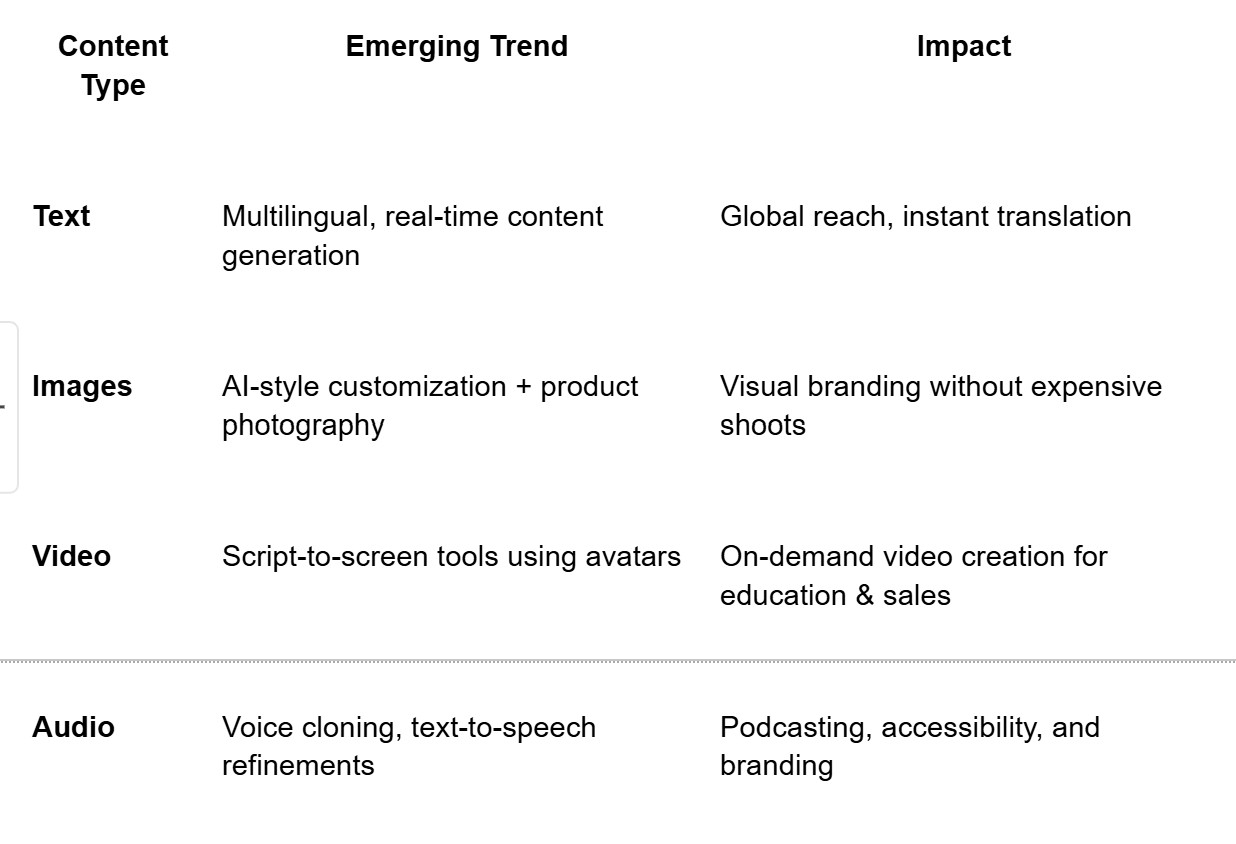
Other key innovations include:
- AI that understands tone, mood, and emotional response
- Hyper-personalized content generated for individuals, not just audiences
- Integration with VR and AR to create AI-driven storytelling experiences
- Real-time analytics feeding AI prompts for adaptive content
From where I sit, the future lies not in replacing creatives, but in giving them tools that expand what’s possible.
AI will help us tell stories faster, deeper, and more globally—but the heart of great content will still come from human insight.
Here’s a breakdown of key risks:
- Hallucination: Confidently incorrect or misleading information
- Bias: Trained on skewed datasets, leading to insensitive content
- Over-automation: Weakens brand originality and user connection
- Compliance risks: AI may generate non-compliant or unverified claims
Even in marketing, I’ve found that outputs often require 15–30% editing to align with tone, accuracy, or brand guidelines.
AI can support human creativity, but it shouldn’t replace oversight, originality, or ethical responsibility.
9. Best Practices for Using AI Generated Content
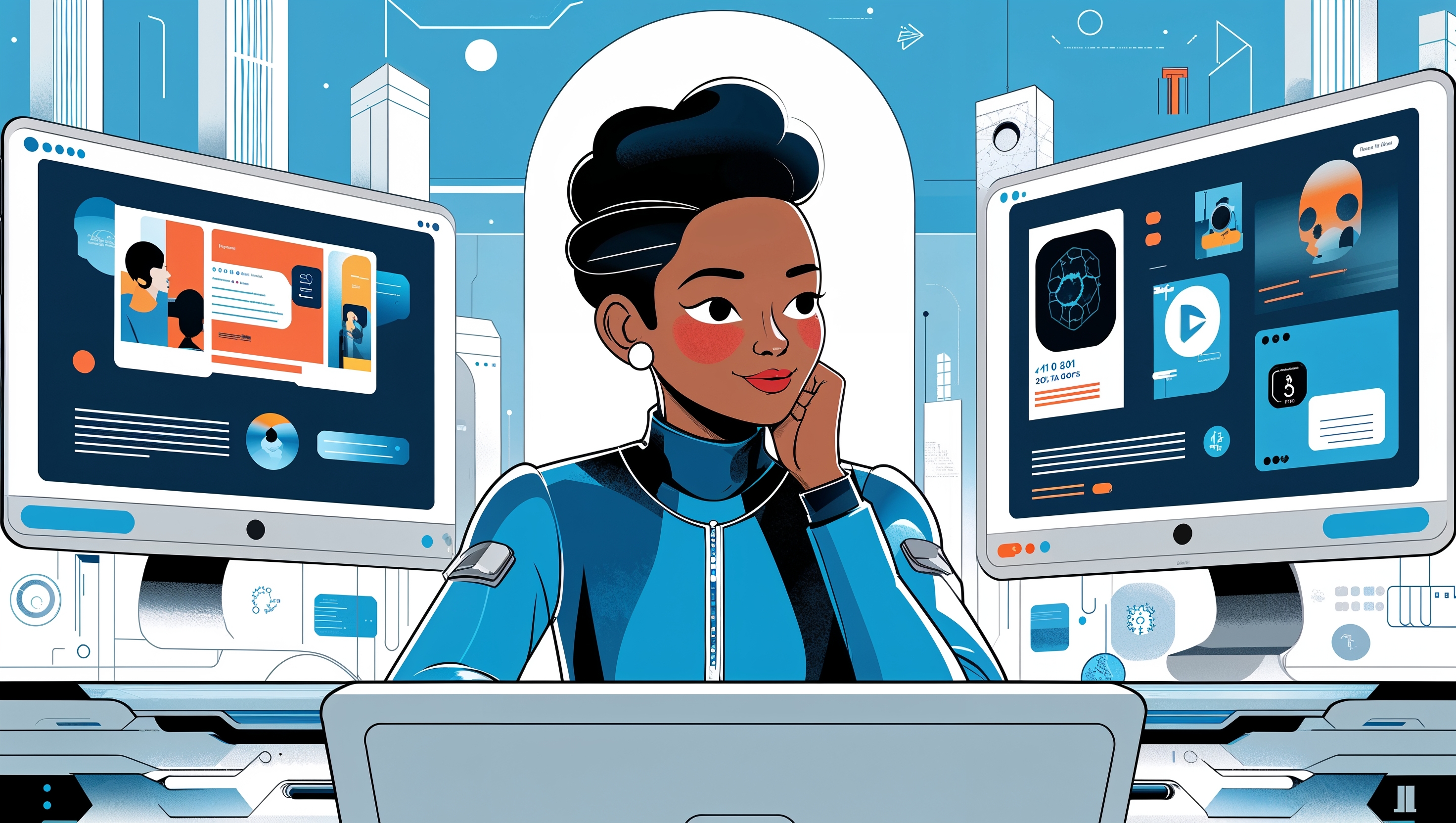
As powerful as AI generated content can be, it takes more than just prompts to produce high-quality, brand-aligned work. The real magic happens when creators apply thoughtful workflows and consistent editorial oversight.
One of the first best practices is to treat AI as an assistant, not a replacement. The most effective content comes when you pair AI's speed with human insight. This applies to everything from machine-generated text to AI video generation—you still need to shape the tone, fact-check the results, and ensure emotional resonance.
Prompts matter more than people realize. Writing detailed, context-aware prompts leads to significantly better outputs. Don't just say “write a blog post”—frame your topic, audience, tone, and desired structure clearly.
Editing is essential. Even the best AI writing tools can produce repetitive or vague phrasing. A good practice is to refine every AI draft for clarity, originality, and accuracy.
Here are additional best practices I recommend:
- Use AI for ideation, not final execution
- Always review and humanize outputs before publishing
- Blend AI with SEO tools for better optimization
- Avoid automating sensitive or factual content without oversight
- Maintain brand tone through style guides or preset templates
Additionally, respect copyright and disclosure norms. If you're publishing automated content writing at scale, it’s wise to let readers know if AI played a significant role—especially in industries like journalism or education.
From personal experience, the most effective AI content strategies focus on augmentation—not automation. When paired with the right intent and follow-through, content automation software doesn’t just save time—it multiplies creative impact.
10. FAQs
1. Is AI generated content detectable by Google?
Yes, Google can detect patterns in AI-generated content, but it's more focused on quality than authorship. Well-edited, helpful content—AI or human—can still rank.
2. What are the risks of using machine-generated text?
The biggest risks are factual errors, repetition, or tone mismatches. Without human review, it may also include biased or inappropriate content.
3. Can I use AI writing tools for commercial projects?
Absolutely. Most tools grant commercial rights, but you should always check the platform's licensing terms before use—especially for client or published work.
4. What’s the difference between NLG and NLP in content creation?
Natural Language Generation (NLG) creates new content, while Natural Language Processing (NLP) analyzes and understands existing text. Most AI tools use both.
